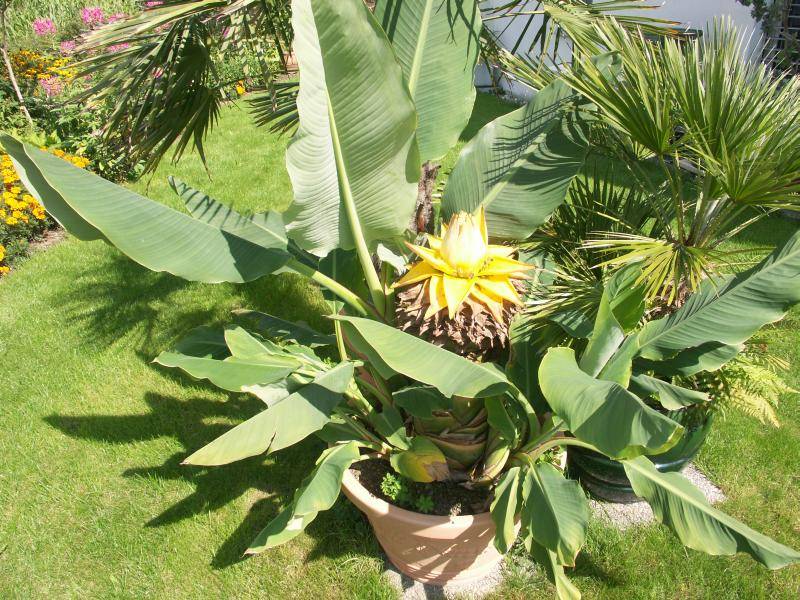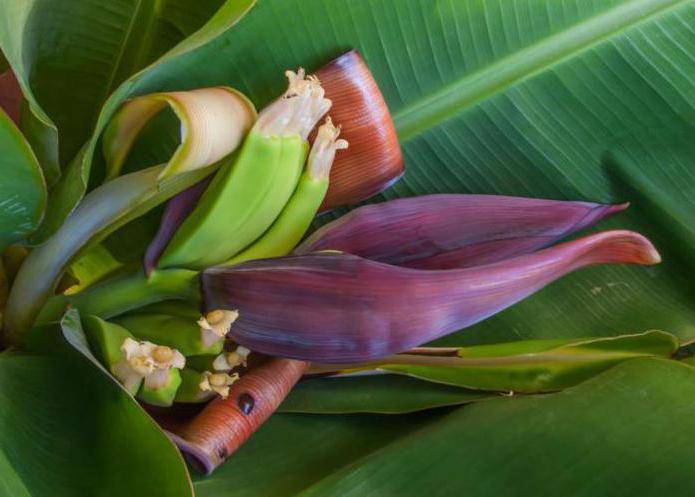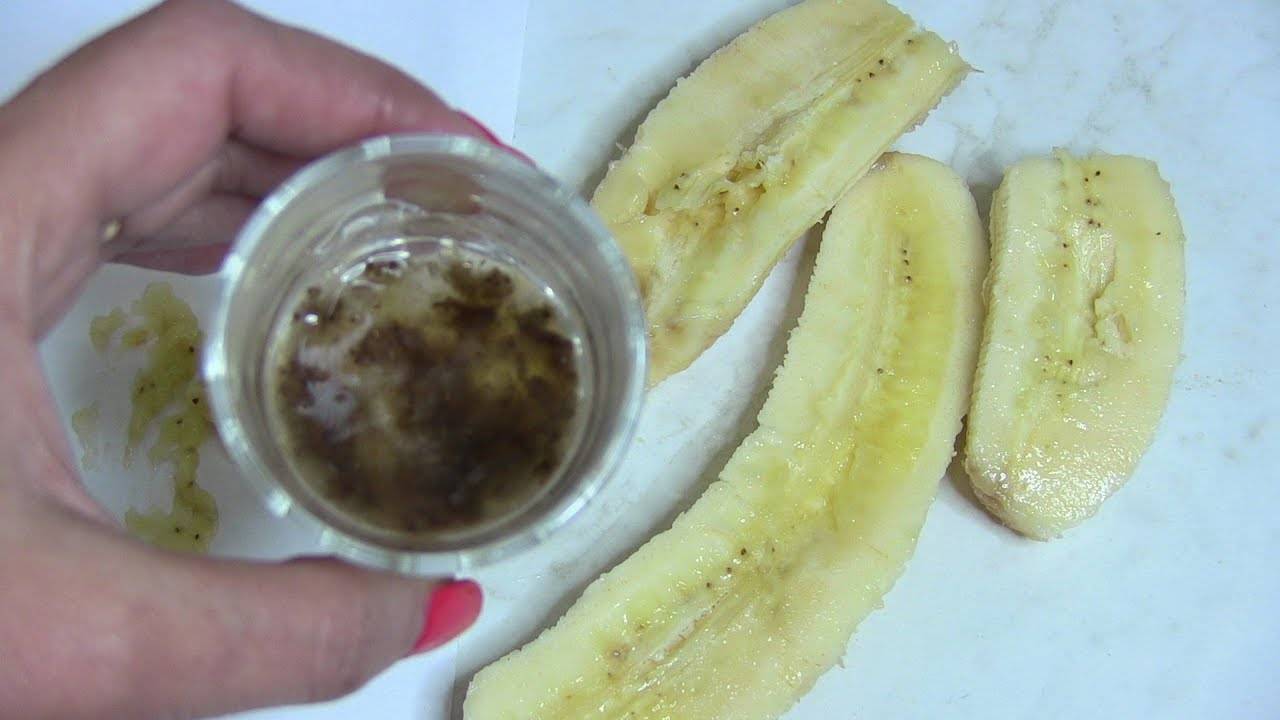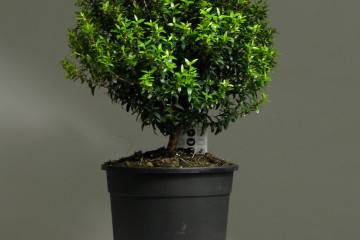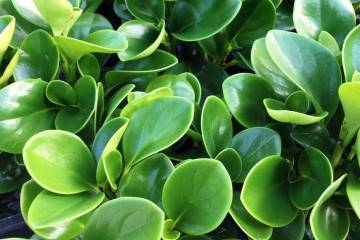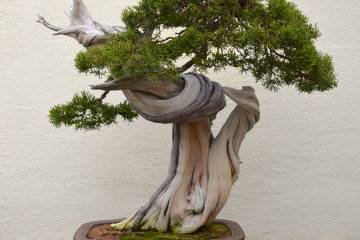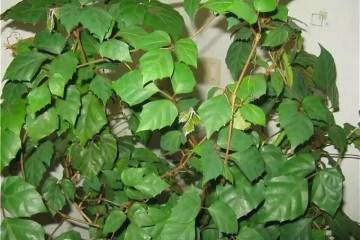How to grow a banana at home
Content:
No florist will miss the opportunity to have an exotic plant in his home garden. It is doubly pleasant when you manage to impress others by the fact that among the usual flowers there is a plant that is known to everyone, but its cultivation is not typical for Russia. Therefore, many are interested in how to grow a banana at home. And it turns out that this is possible.
How to grow a banana at home
To grow a banana at home, you have to try. But it's worth it, because these plants will bring a touch of originality and unusualness to the interior of any apartment.
What does a homemade banana look like?
An exotic plant can be recognized by the following features:
- in a tropical climate, banana trees reach 12 m in height, but at home they do not grow higher than 2 m;
- the length of the sheet reaches 2 m, and the width can be 1 m;
- the bases of the leaves adhere tightly to each other, due to which a pseudostem is formed;
- the stem itself is underground, it also performs the functions of a root;
- inflorescences are formed in the middle of the ground stem, always die off after flowering.
Varieties for growing in the room
There are several varieties of home grown bananas. Some of them, with proper care, are capable of bearing fruit:
- Pointed banana;
- Cavendish is a dwarf;
- Cavendish super dwarf;
- Kiev dwarf;
- Kiev superkalik.
In addition to fruiting, decorative indoor varieties are also grown:
- Velvety;
- Lavender;
- Chinese dwarf;
- Bright red.
Ornamental varieties are grown for their stunning colors. Fruits are formed on some of them, but they are inedible.
Features of caring for a banana at home
- Temperature
Since the banana is a tropical plant, the temperature for growing it at home must be high throughout the year.
In summer - not lower than +26 ° С, in winter - at least +20 ° С.
- Lighting
This plant needs bright sunlight. The growth of a banana, its development and flowering depends on this.
The southern window sills are best suited, the southeast and southwest windows will also fit. But on the south side, it needs to be shaded from the bright sun to avoid sunburn.
- Watering
An abundance of moisture is what is needed for the development of a homemade banana. The soil must not dry out. In the summer they water three times a week, in the winter they reduce watering to once. You can water the plant with a warm shower. This will refresh and delight him. Water the plant with warm, settled water.
- Spraying
Since tropical exotic loves high levels of humidity, spraying should be done regularly. They should be especially frequent during hot, dry summers and during the heating season. At this time, three daily spraying is required.
- Humidity
Air humidity must be at least 65%.
This condition is difficult to fulfill in an apartment. Therefore, constant spraying is needed, the pallet must be filled with wet expanded clay or moss. An open vessel with water is placed next to the pot.
To create the required level of humidity, special air humidifiers are used.
- Priming
Before preparing the soil, you need to decide on the choice of the pot in which the banana will be planted. The very first flowerpot should be about 2 liters, later the plant will grow to a 50 liter pot.
The soil should be nutritious, loose, air-permeable, with a neutral pH level. In flower shops you can find potting mixes that are made specifically for bananas. This is the best option.
When self-preparing the substrate, you will need: turf, sand, peat, leafy soil (1: 1: 1: 2). Coconut substrate, marsh moss, vermiculite are added to this mixture, they will make it looser.
- Top dressing
Banana likes regular feeding. Organic and mineral fertilizers are applied once a week after watering. You can use ready-made universal solutions sold in flower shops. After fertilizing, the plant should be shaded for a day.
- Features of care in winter, dormant period of a banana
There is no specific rest period for a banana. It's just that in winter the temperature in the room drops to + 20 ° C.
In winter, the owner of the plant independently chooses a short period of time during which the banana will rest a little. At this time, it is not fed, less often watered and sprayed.
- Banana pruning
Pruning is not necessary for domestic varieties. But some growers cut off an adult plant at the root. Very soon, new young shoots are formed.
When and how it blooms and bears fruit
Homemade banana grows fast enough. For 3 years, it already forms about 15 long, wide leaves.
During this period, in mid-July, its first flowering may occur. On its upper part, a leaf is formed that resembles a heart. An inflorescence-panicle of cream or light green color appears from the center. As it develops, the inflorescence grows and goes down.
This process takes up to 3 months. Flowers are heterosexual and bisexual. As soon as the female flowers are pollinated, the fruit begins to develop. The leaves gradually turn yellow and die off. With proper care, the banana will begin to bear fruit.
How banana reproduces
Banana can multiply in three ways:
- Seed method. The plant germinates from seed. This is the most difficult method as the banana seed has a hard skin that is difficult for the sprout to hatch through.
- Division. Produced during the transshipment of the plant. A piece with a process is cut off from the rhizome with a sharp knife. It is treated with crushed charcoal and planted in a separate pot.
- Reproduction by shoots. It can be produced in the case of a shoot with several leaves. This stem is cut off, sprinkled with coal and planted in a separate flowerpot.
It is more convenient to grow new plants from shoots or by dividing part of the root. These processes are painless for an adult banana, and young plants take root and develop faster.
Growing a banana from seeds at home
For tourists traveling to Thailand, China, India and other Asian countries, there is an opportunity to come across mini bananas with seeds. These seeds can be used to grow this plant at home.
Before planting, the seeds are soaked for 1 month. This period is necessary to soften their dense shell. After soaking, the casing should be cut off with a nail file or sandpaper.Then the seeds are planted in a well-moistened soil, they are buried.
The top of the container is covered with glass or transparent film.
The first shoots appear in 70-80 days. Young seedlings are determined for permanent residence.
How to get seeds from a purchased banana and germinate them
To get seeds from a purchased banana you need:
- Choose a large, ripe banana.
- Put it in a plastic bag and wait for the skin to darken completely.
- Peel the fruit and cut it lengthwise into two equal parts.
- Remove the seeds from the pulp with a sharp object and spread them out on a paper napkin.
- Try to find the rounded seeds, keep them, and discard the rest.
- Rinse the seeds well to completely separate the pulp.
- Pour the future planting material with warm water and put it in a warm place for 2-3 days.
- Rinse and dry thoroughly.
After that, the seeds are laid out in a neutral substrate for germination. This can be sphagnum, coconut, which can be purchased at a flower shop. Seeds can germinate up to 3 months.
Banana transplant
Florists need to know when and how to plant a banana at home. Equally important is information about when it is time to replant the plant.
Moving the banana tree to a new pot is done annually in the spring. Young plants are transplanted every six months. Each new pot should be 4-5 cm larger than the previous one in diameter.
A drainage layer is laid out on the bottom. The transfer is carried out by the transshipment method. Empty places are filled with fresh soil, and in mature plants the topsoil is also renewed. After that, the bush is watered abundantly, after 2 days they are loosened, and after a week they are fed.
Possible growing problems
There are a number of problems that prevent a home plant from fully growing and developing:
- The plant stops growing. This can be due to a lack of lighting and a too cramped pot.
- Dried leaves at the edges appear due to low air humidity.
- Black-brown spots on the leaves appear due to excess moisture, as a result of which the roots begin to rot. The plant is transplanted into a new substrate, the damaged roots are cut off.
- Mucous rot on the aerial part appears due to excess moisture combined with a low temperature. In order to revive life in the tree, damaged roots are removed, the cuts are processed with charcoal, watering and temperature regimes are regulated.
Rarely, pests can appear on a banana tree, which most often get there from neighboring plants. Insecticides sold in flower shops will help fight them.
Growing a homemade banana is a complex, time-consuming process. This plant needs special conditions that must be maintained constantly. But if there is a desire, there will be opportunities. The result is a gorgeous plant with amazing flowers or edible, home grown bananas.


